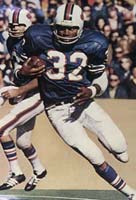Buffalo Bills Running Back
O.J. Simpson, who played with the National Football League’s Buffalo Bills from 1969-1977, is without question the greatest player to ever wear the team’s red, white and blue. Greatness was no stranger to Simpson even before his arrival in the Queen City. In college, Simpson simply sparkled. An All-American in all four years of his collegiate football career (1965-66 at City College of San Francisco and 1967-68 with the University of Southern California Trojans), O.J.’s icing on the cake came when he was named the Heisman Trophy winner in his senior year. In addition, he was named both the Associated Press and United Press International 1968 College Athlete of the Year.
Chosen by Buffalo in the 1969 AFL-NFL draft, Simpson would play 10 seasons for the Bills. In that span, O.J. would set numerous franchise records, including most career rushing yards (10,183) and highest career rushing average (4.8 yards per carry).
Simpson enjoyed a career year in 1973 when he became the first pro runner to gain 2,000 yards in one season, finishing the year with 2,003 in just 14 games.
O.J. would eventually become the second leading rusher in National Football League History, while being named the American Football Conference Most Valuable Player three times (1972, ’73, and ’75) and the NFL Most Valuable Player once (1975).
Simpson finished his illustrious career with the San Francisco 49ers in 1978. O.J. was twice honored in retirement for his achievements on the field. In 1983, he was inducted into the College Football Hall of Fame. Later, in 1985, O.J. was inducted into the Pro Football Hall of Fame in Canton, Ohio – the first Buffalo Bill to be so honored. After his football career, Simpson became a football analyst for NBC-TV and an actor,appearing in several films, including the highly successful “Naked Gun” movies.


